From this post, you can download the latest version of the Android SDK Platform Tools. We have provided the tool for Windows, macOS, Linux, and Ubuntu operating systems. Follow this guide to familiarize yourself with its features, usage, and some of the common commands you could execute using it.
Android ecosystem is always regarded as the epitome of customization. The reason for the same stands simple- being open source in nature, it offers a plethora of tweaks and modifications. Generally, you would have already tried out custom launchers, icon packs, themes, and other UI changes. But these are just the tip of the iceberg. There is a plentitude of other customizations possible. These include unlocking your device’s bootloader, replacing stock recovery with a custom recovery like TWRP, and flashing an ocean of mods, frameworks, ZIP, and IMG files, among others.
Likewise, there’s also a possibility to flash a new kernel and overclock or underclock the CPU power. Along the same line, rooting is another pretty famous tweak users like trying out. The latter gives you administrative privileges and allows for modification to the system partition. But for all of these to be effectively carried out, there is a pretty important prerequisite. Your PC should have the Android SDK Platform Tools installed. Until and unless you have it installed onto your PC, chances are you won’t be able to carry out any of the abovementioned tweaks. But why does this happen? Let’s check out. After this, we will check out its usage and share the said build for Windows, macOS, Linux, and Ubuntu systems.
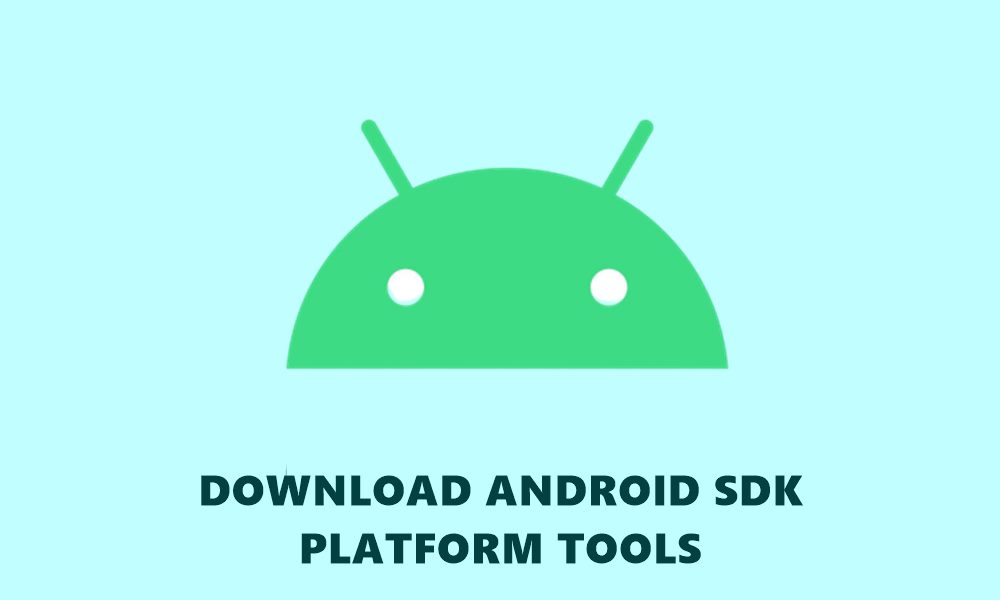
Page Contents
The Need for Android SDK Platform Tools
One pretty important thing to discuss is why you will be needing this tool. Well, consider it like this. When you connect your device to PC to transfer files, images, and videos you need the device-specific USB Drivers installed. If they aren’t installed, your PC will simply refuse to identify the connected device or would show it as an unrecognized device. Similar is the case with these tools, although its usage goes a step further. These tools aren’t needed when you connect your device to a PC for file transfers. Rather, the need for these tools arises when you are about to carry out ADB and/or Fastboot commands.
If these tools are installed, your device will only be identified by the PC in fastboot or ADB mode. There are many commands you would need to carry out the abovementioned tweaks. Well, the first and foremost requirement is an unlocked bootloader. Unless you do so, you won’t be able to try any higher-level customizations. But even to unlock the bootloader, you must have the Android SDK Platform Tools installed. Apart from that, here are some of its other pretty important usage:
Also Read
Booting Device to Bootloader/Fastboot:
Using the ADB and Fastboot binaries, you could easily boot your device to bootloader or fastboot mode. Just enter the adb reboot bootloader command, and that’s it. The best thing about this code is that it is universally applicable to all Android devices.
Booting to Recovery:
Booting your device to a custom recovery like TWRP or the stock recovery is also possible just by this single line of code: adb reboot recovery.
Checking ADB and Fastboot connection:
To ensure your device has been successfully booted to ADB or Fastboot modes, you could easily execute a single line of code, granted you have installed the Android SDK and Platform Tools on your PC—type in adb devices to check for ADB connection or fastboot devices for Fastboot connection verification.
Unlock Bootloader:
As already mentioned, the fastboot oem unlock command opens the gate to many customizations.
Flashing ZIP Files:
You could also flash the ZIP files like the TWRP installer using the fastboot flash recovery recoveryname.zip
Booting IMG Files:
Likewise, booting your device via IMG file is also quite easy. We usually do so while booting TWRP Recovery to any A/B partition device by using the fastboot boot recovery.img
Rebooting Device:
Furthermore, you could directly boot your device to Android OS from the fastboot mode using the fastboot reboot command.
To be fair, these are just some of the commands being used on a normal basis. There exists tons of other ADB and Fastboot commands that you could/would come across while dealing with these customizations. But not a single code will be executed successfully if you don’t have the Android SDK Platform Tools installed on your PC. So with this, we guess by now you might have got a pretty strong idea as to the need and importance of this tool. Let’s now proceed ahead with the download links as well as the usage instructions for this tool across various platforms.
What’s New in Version 34.0.5 (October 2023)
34.
- adb
- adb now defaults to libusb on macOS to address issue #270205252.
- Previously, adb responded with a successful code when wireless pairing fails. Resolved this by returning a failure code (1) and user-facing error (
error: protocol fault (couldn't read status message...)).echo $?now reports1. adb wait-for-disconnectis now operational for non-USB (wireless debugging).- Added new DbC interface for future support of ChromeOS over adb.
- fastboot
- Fixed flashall on Pixel 3 devices.
34.0.4 (July 2023)
- adb
- Propagate
-a (gListenAll)when adb forks an adb host server (previously, the flag only worked foradb -a server nodaemon) - Faster root and unroot
- Reland
Flag(env) guarding clear endpoint (device) feature for OSX usb start.(issue #270205252).
- Propagate
- fastboot
- Mac: remove retries on invalid IO iterator (flashing failure with LIBUSB_TRANSFER_CANCELLED)
- Windows: fix “Sparse file is too large or invalid” when using “flashall”
- All platforms: fix “ANDROID_PRODUCT_OUT not set” when using “update”
34.
- Updated with the release of Android 14 Developer Preview 2.
34.
- adb
- macOS: Reverted “unstable connectivity (MacBook high speed cable)” resolution due to adb install hang (issue #270205252).
- fastboot
- Windows: Fixed “mke2fs: Illegal or malformed device name while trying to determine filesystem size” error introduced in Platform tools 34.0.0 (issue #271039230).
34.
- adb
- Fixed zero length packet sends for macOS (issuetracker: 208675141).
- Addressed unstable connectivity (MacBook high speed cable): frequent adb disconnects.
- Improved error message for adb push with insufficient number of arguments.
- fastboot
- Improved flashing:
flashallwill now skip reboots to userspace if it can. - Fixed zero length packet sends for macOS (issuetracker: 208675141).
- Fixed flashing recovery.img resulting in wrong AVB footer.
- Improved flashing:
Download Android SDK Platform Tools:
You could now download and install the Android SDK Platform Tools for your operating system from the below links:
For Windows:
- Download File: Download
For macOS
- Download File: Download
For Linux
- Download File: Download
How to Install Android SDK and Platform Tools:
Once you have downloaded the ZIP package from above, extract it to a convenient location on your PC. However, it is highly recommended that there shouldn’t be any spaces between the names of the folder. For example, C:\GetDroidTips\platform-tools is the correct example, but C:\Get Droid Tips\platform-tools isn’t. Moving on, once you have extracted the folder, you should see the name as platform-tools. Here is how that folder looks in the case of Windows.
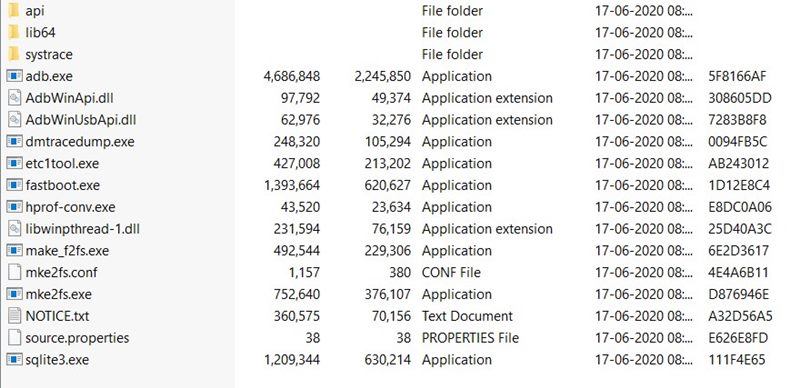
Now to execute any ADB or Fastboot commands, there are two requirements, one on the device side and the other on your PC. First, let’s check out what needs to be done on your Android device. After which, we will shift our attention to the PC side.
STEP 1: Mobile Requirements- Enable USB Debugging:
So that your device gets recognized by your PC in the Android Debugging or ADB mode, you will have to enable USB Debugging. Here is how it could be done:
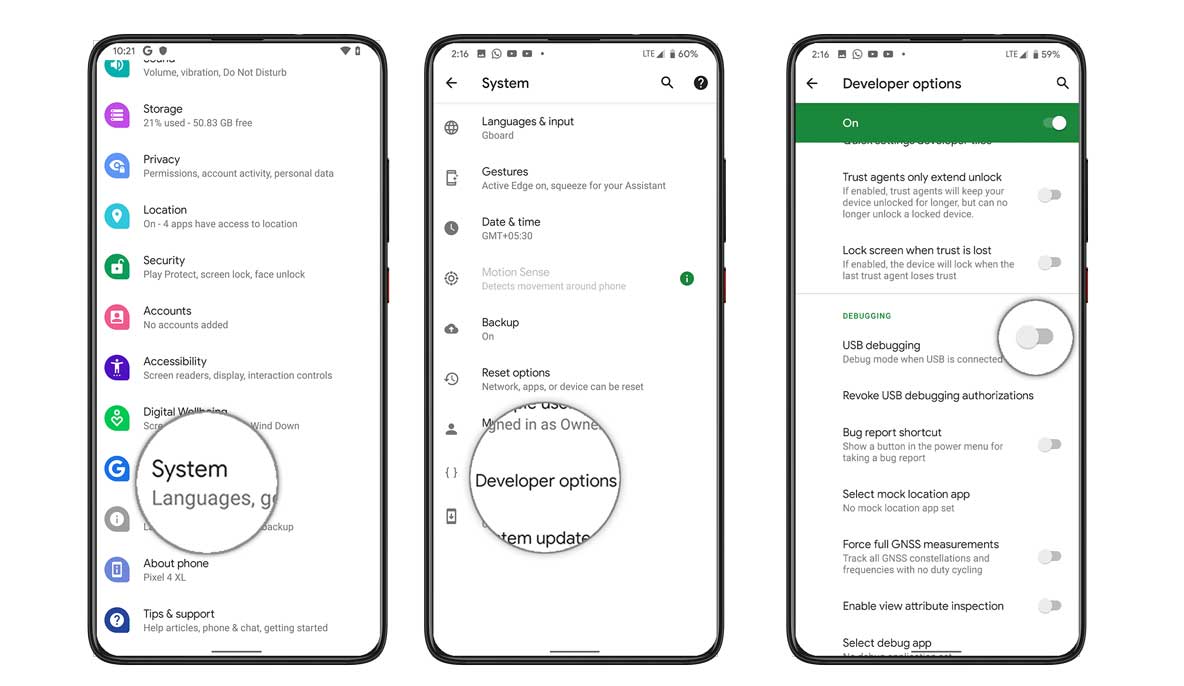
- Head over to Settings on your Android device.
- Navigate to About Phone and tap on Build Number 7 times.
- Then go back to Settings > System and tap on Advanced.
- You should now see the Developer Options. Within that, enable the USB Debugging toggle.
- Now connect your device to your PC via a USB cable and move over to the next section.
STEP 2: PC Requirements- Entering Commands:
There are two ways of entering commands on your PC: Command prompt or Windows Power Shell. Let’s check out both methods.
Executing Commands via Command Prompt
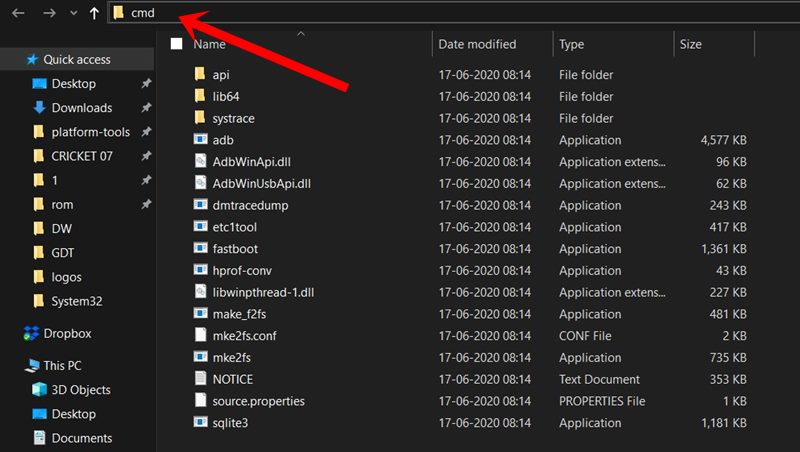
- If you wish to take the CMD route, then here is what needs to be done:
- Head over to the platform tools folder on your PC.
- Type in CMD in the address bar inside that folder and hit Enter.
- This will launch the Command Prompt. Now type in the desired command, and that is it.
Entering Commands in PowerShell Window:
- Head over to the platform tools folder on your PC.
- While pressing the Shift key, right-click in an empty area inside the platform tools folder.
- From the menu that appears, select Open PowerShell window here (in Windows 10) or Open command window here (in earlier builds of Windows).
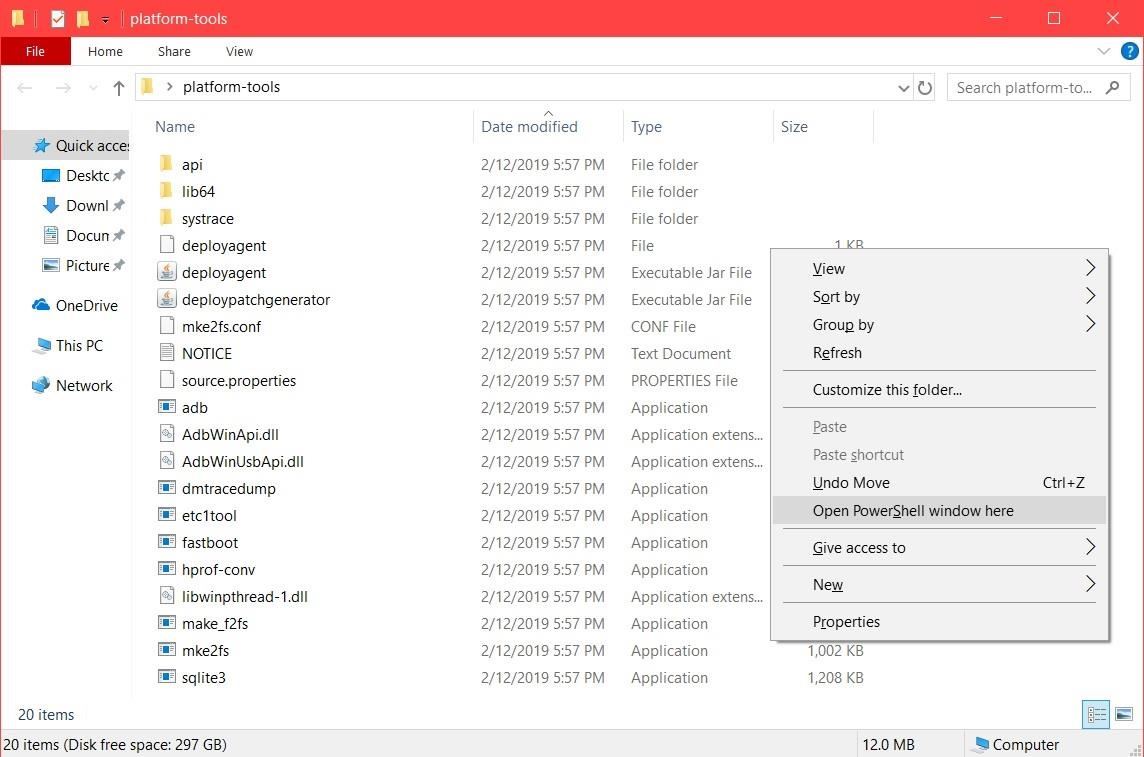
- Type in the needed commands and hit the Enter key to execute them.
However, do keep in mind that if you are using the PowerShell window, you might have to prefix ./ before each command. So to avoid any confusion, many users prefer to go ahead with the Command Prompt window itself.
STEP 3: Identifying your Device in ADB or Fastboot Mode:
Now that you have enabled USB Debugging and opened the PowerShell or Command prompt, here is how to begin with the ADB commands.
- Type in the below command and hit Enter
adb devices
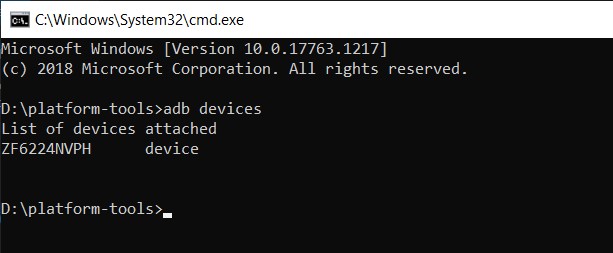
- You should now see a prompt on your device, asking for USB Authorization. Tap on Allow and if it’s your PC, you should also tick mark the “Always allow from this computer” option, as shown below.
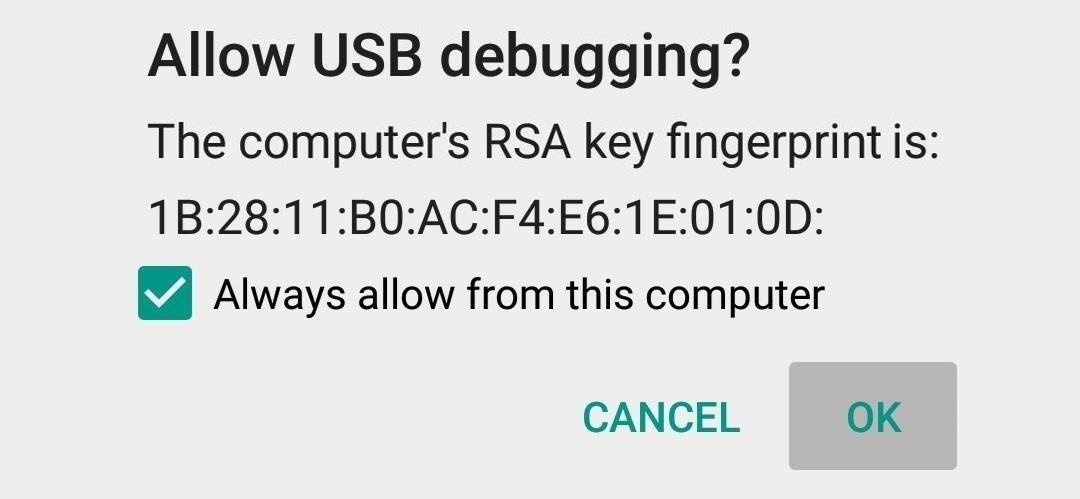
- Once that is done, you should now see an alphanumeric string followed by the adb keyword. This signifies that your PC has successfully recognized your device in ADB Mode.
- For fastboot mode, type in the below command and hit Enter:
adb reboot bootloader
- Now enter the below code and if you get the alphanumeric code followed by the fastboot word, the fastboot connection has been successfully established.
fastboot devices
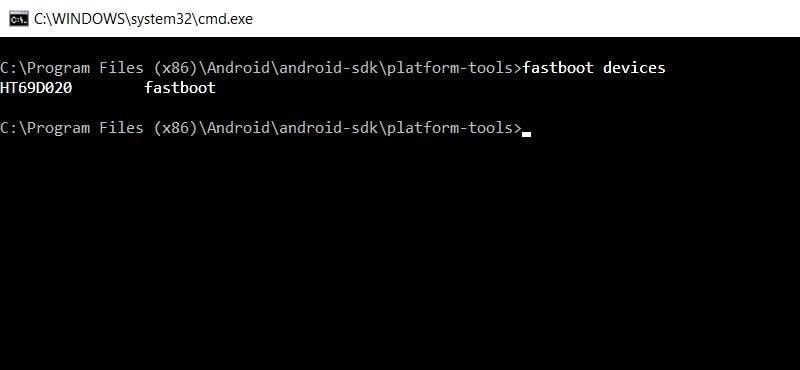
That is it from this guide. We have provided the Android SDK Platform Tools download links, the installation steps, and some of the pretty important ADB and Fastboot commands. If you have any queries concerning any of the above-mentioned steps, do let us know in the comments section. Rounding off, here are some iPhone Tips and Tricks, PC tips and tricks, and Android Tips and Trick that you should check out as well.

thank you
Hi! Your second link says for Windows. But it’s the link for the latest mac version of the program. That’s all. Thanks for the wonderful guide!
Thanks for Pointing our mistake.
wow thank u
Hi my Tecno camon cx air becomes loos system ui, What shal I do?
Comment:cool
thank you
Please help how to root Tecno spark 3.
i went to update Android pie with Lenovo k8 plus
can i use adb to unlock a phone if
how do i use adb to unlock a phone
Mera name parmeshwar hai mujhe realme format tool
bagaimana memperbaiki kernel rev. check fail device:1 binary:0
Samsung a7 2018
Learned a whole lot. Surprisingly easy to fully grasp. Thanks for sharing :)
what can i do. . my zenfone 3 laser is not charging after i update the new os to oreo. .
I love this adbs are working good
Oppo k5 can’t be rooted this video are fake
meizu c9 pro root, imei repair help me….
Sir. I have problem I want making root on my device oppo a5s and install twrp but here is no available this type twrp I need help you help me
My phon itel a32f Android no srppert usb drive pleass hellp me
Okay I downloaded the android and zip file and extracted all the files how do I install the android sdk ??
Just extract it to the C Drive.
tanks for this app
plz sir q mobile noir z8 ko adb cmd k mada say kasy conected kerty hain sir plz help me
Symphony i68 root and twrp fastboot flash video please?
Need symphony i68 twrp,please sir YouTube video release soon,9.0 pie,sp9832e chipset,twrp share us if possible? Thanks.
How to unlock bootloader for itel s15?
Alhamdulillah, downloading the ADB, Fastboot-android SDK platform tool. thanks alot for sharing with us Sir
Hvorfor i Himmelens navn, vitsen med å gjøre det så vanskelig, for vi som ikke er datakyndig, nei lag en enkel måte å laste inn oppdateringer og et sammensydd program som løser verdens problemer.
Good luck 🍀🤞حيذا.
Yes, I ahve a comment. On this page you show how to download the file for Windows, Mac or Linux and yet … you only show how to install it using Windows, so people like me (Linux) will not know what to do.
Hi, adb recognizes the device normally and can reboot it in bootloader mode, but when in the fastboot screen it stops recognizing it and says “error: no devices/emulators found”, despite it being able to list the device before entering fastboot mode. Can you please help? I can’t find any such situation online where adb works on normal boot but does not recognize it in fastboot. Thank you.
where can i get the SDK manager?
We have already given the downloads, please check the download heading.
I tried but my phone is stuck at recovery or fastboot mode, I can’t acess the settings and witch on the usb debugging… How can I do it?
what the device is bricked, it does not pop up at all
hi what if i don’t get a hexadecimal code after executing this “fastboot devices” command?
after i enter adb reboot bootloader my Xperia Z4 sreen is black and shows no more reactions
i forgot to mention i use WIN 11 is that the reason for the black screen?
Hello I have gone through all Steps but after I have
adb reboot bootloader entered the screen of my Xperia Z4 remains black and no longer responds, I have to disconnect it from the power then it restarts, I work with WIN 11 can you give me a hint please thanks Michael
ok i read it again, you actually mentioned it, but you put the important stuff right under “4- press enter to make it work” many people would think it was to elaborate what the step 4 does instead of the important warning, if you know how to design website you should know that the most important thing you should make it bold or have other color, people hate reading stuff you know.
Hello Syed,
I have downloaded and Extracted Platform tools twice on 2 different machines and the application will not open. either by command prompt or run as admin.
Can you please help, I am Trying to Load the Android Pie 9.1 OS in my Moto z3 play
Hi, after
adb reboot bootloader
the device reboots. Next command
fastboot devices
does not return anything…
How can I continue?
I’ve downloaded platform-tools_r34.0.4-windows.zip. After unzip I’ve got files with other length as here listed, all are dated 12.2007, and the 3 subdirectories are missing.
Besides, file no-verity-opt-encrypt-6.0.zip is unable to be downloaded, “File not found”.
Please your advice.
I get an error in cmd after typing in adb devices saying:
DNS server not authoritative for zone.
There is not to be found what commands to use, to use the adb devices command
Phone is today missing😡
I could not see my device while running adb devices
While testing ADB connection with PC by command “adb devices” command said :
Daemon not running
Could not read ok from ADB Server
*failed to start daemon
adb.exe : failed to check server version: connot connecting daemon.
What should I do ?
Do I did somethint wrong ?
Why this error ?
Thank you for your tutos well made but i don’t understand at this step. Help
I had success with my Samsung Galaxy Ace 3 GT S7270 all the way until the last comment “fastboot devices”, nothing returned except another command line prompt. Anything else I need to do to get the alphanumeric code followed by the fastboot word? Without that, I’m not sure if the fastboot connection has been successfully established.